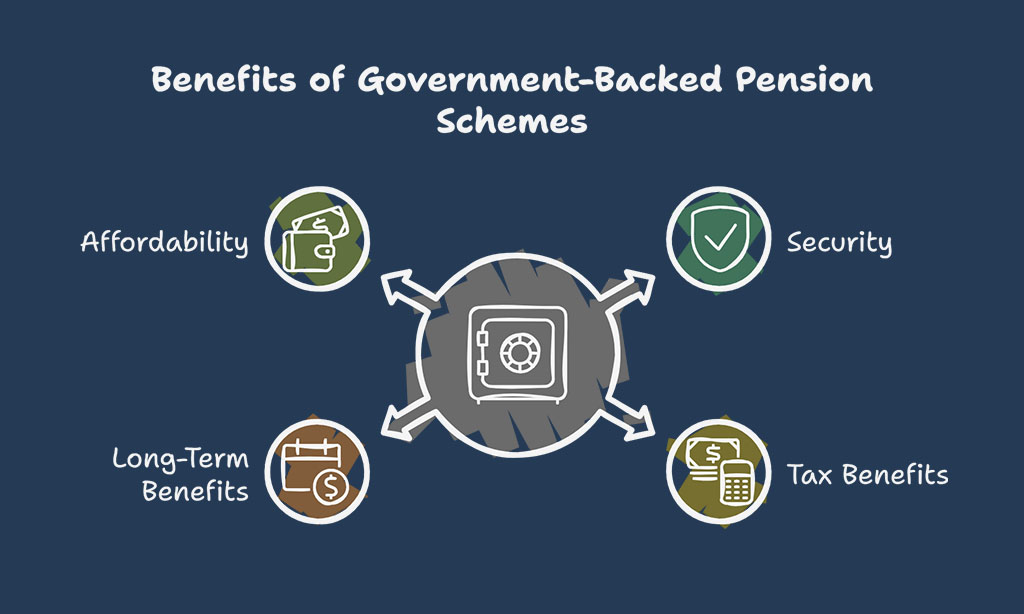Planning for retirement is a crucial financial decision that can impact your quality of life during your later years. As India’s working population continues to grow, the need for effective retirement planning is more important than ever.
In this context, government-backed pension schemes have emerged as a reliable option for individuals looking to secure their financial future.
With the increasing variety of options available in 2025, it’s essential to explore the Top Government-Backed Pension Schemes in India that can provide stability, growth, and security during your retirement.
This article will guide you through the top government pension schemes available in India today, highlighting their features, eligibility, and benefits.
Whether you are a young professional just starting your career or someone planning for retirement, this comprehensive guide will help you make informed decisions about your pension investment.
Introduction to Government-Backed Pension Schemes in India
Pension schemes are financial tools designed to help individuals save and invest for their retirement. In India, these schemes are typically backed by the government to provide a sense of security to citizens once they are no longer earning a regular income.
Government-backed pension schemes are particularly attractive because they offer safety, low-risk investments, and potential tax benefits.
These schemes are structured to ensure that individuals receive a regular income after retirement, enabling them to maintain their standard of living.
The Indian government has introduced a variety of pension options to cater to the needs of different demographics, including salaried employees, self-employed individuals, and even senior citizens.
Why Choose Government-Backed Pension Schemes?
There are several reasons why individuals prefer government-backed pension schemes over private retirement plans:
- Security: Since these schemes are supported by the government, they are relatively low-risk. The government guarantees that individuals will receive their pension payments as promised.
- Tax Benefits: Many of these schemes come with tax incentives, making them an attractive choice for tax-saving purposes.
- Long-Term Benefits: Government pension schemes are designed to provide regular income after retirement, ensuring a steady financial flow in your later years.
- Affordability: Most government pension schemes require small, manageable contributions, making them accessible to people from all income brackets.
- Wide Reach: These schemes are available to a wide demographic, including low-income groups, self-employed individuals, and salaried professionals.
Benefits of Securing Your Future with Government Schemes
Investing in government-backed pension schemes helps individuals prepare for unforeseen circumstances that may arise during their retirement years. With increasing life expectancy, having a reliable source of income becomes even more critical. Here are some key benefits:
- Financial Stability: Government pension schemes ensure that you have a financial cushion when you are no longer earning.
- Stress-Free Retirement: These schemes reduce the stress of managing finances during retirement, letting you enjoy your golden years.
- Social Security: With growing social and economic uncertainties, having a government-backed pension plan guarantees a source of income after retirement, regardless of market fluctuations.
Top Government-Backed Pension Schemes in India [2025]
India offers a variety of government-backed pension schemes that are structured to suit the needs of different individuals. Let’s dive into the Top Government-Backed Pension Schemes in India in 2025.
1. National Pension System [NPS]
The National Pension System [NPS] is one of India’s most popular retirement schemes. It is an attractive option for anyone looking for long-term investment growth, offering tax advantages and flexibility.
- Open to All Citizens: Any Indian citizen between the ages of 18 and 70 can open an NPS account, making it accessible to both young professionals and retirees.
- Low-Cost Structure: The NPS offers a low-cost investment structure, ensuring that more of your contributions are invested for growth.
- Tax Benefits: Contributions made to NPS are eligible for tax deductions under Section 80C of the Income Tax Act. Additionally, there is an extra ₹50,000 tax benefit available under Section 80CCD[1B], which is not available in other schemes.
- Investment Flexibility: NPS allows you to invest in equity, government bonds, and corporate bonds. You can choose your asset allocation based on your risk appetite.
How to Enroll in NPS
Opening an NPS account is straightforward. You can visit an NPS branch, or do it online via the official website. You will need your Aadhaar number, PAN card, and bank details to complete the process.
NPS Tax Benefits and Contributions
NPS offers significant tax-saving opportunities. The total maximum deduction on contributions to NPS [under Sections 80C and 80CCD[1B]] can go up to ₹2 lakh. The flexibility to choose between equity and debt funds makes NPS an appealing option for both aggressive and conservative investors.
NPS Tax Benefit Example: If you invest ₹1.5 lakh in NPS, you can claim a deduction under Section 80C, and if you invest an additional ₹50,000, you can claim the extra tax benefit under Section 80CCD[1B]. This allows for a total tax-saving benefit of ₹2 lakh annually.
| NPS Contribution Structure | Employee Contribution | Employer Contribution | Total Contribution |
| Salaried Employees | 10% of basic salary | 10% of basic salary | 20% of basic salary |
| Self-Employed Individuals | Minimum ₹500 per month | N/A | Variable |
2. Employees’ Provident Fund [EPF]
The Employees’ Provident Fund [EPF] is one of the most widely used retirement schemes for salaried employees in India. It is mandatory for employees in the formal sector to contribute to EPF, making it an effective retirement savings tool for millions of people.
- Contribution Rate: Both employees and employers contribute 12% of the employee’s basic salary each month towards the EPF. This amount is automatically deducted from the salary.
- Interest Rate: EPF accounts offer attractive interest rates [currently around 8% per annum], which are tax-free, ensuring that your savings grow steadily over time.
How EPF Works for Employees
Each contribution made to the EPF account is divided into two parts: one portion goes towards the Employee Pension Scheme [EPS] and the other towards the EPF itself. The EPF portion earns interest, while the EPS portion provides a monthly pension after retirement.
EPF Tax and Withdrawal Rules
EPF contributions qualify for tax deductions under Section 80C of the Income Tax Act. If you withdraw the amount before five years of service, the amount will be subject to tax. However, if you leave the money in your EPF account after retiring, the interest and principal remain tax-free.
| EPF Contribution Details | Employee Contribution | Employer Contribution | Total Contribution |
| Contribution Rate | 12% of Basic Salary | 12% of Basic Salary | 24% of Basic Salary |
| Interest Rate [Annual] | 8% | 8% | 8% |
| Tax Benefit | Exempt from Tax | Exempt from Tax | Exempt from Tax |
3. Atal Pension Yojana [APY]
The Atal Pension Yojana [APY] is a government-backed pension scheme specifically designed for individuals working in the unorganized sector. It helps ensure a stable pension for low-income workers and offers guaranteed returns.
- Eligibility: APY is available to Indian citizens aged between 18 and 40 years who have a savings bank account. It is a great option for people without regular salaried employment.
APY Benefits and Payouts
- Guaranteed Pension: The scheme guarantees a monthly pension of ₹1,000 to ₹5,000, depending on the amount you contribute and the age at which you enroll.
- Affordable Contributions: Depending on your entry age, monthly contributions range from ₹42 to ₹1,454. For example, a 20-year-old worker contributing ₹42 per month can expect a pension of ₹1,000 per month after turning 60.
APY Contribution Structure
The contribution structure varies depending on the individual’s age. Here’s a breakdown:
| Age of Enrollment | Monthly Contribution for ₹1,000 Pension | Monthly Contribution for ₹5,000 Pension |
| 18 years | ₹42 | ₹210 |
| 25 years | ₹68 | ₹340 |
| 40 years | ₹291 | ₹1,454 |
4. Pradhan Mantri Shram Yogi Maandhan [PM-SYM]
The Pradhan Mantri Shram Yogi Maandhan [PM-SYM] is a pension scheme specifically for workers in the unorganized sector. It ensures that these workers receive a pension after they turn 60.
- Eligibility: This scheme is available to individuals in the unorganized sector between the ages of 18 and 40 who earn up to ₹15,000 per month.
- Contributions: The contributions are low, starting at ₹55 per month for individuals who are 18 years old.
Features of PM-SYM
PM-SYM offers a guaranteed pension of ₹3,000 per month after the age of 60. It is a simple, low-cost option for workers who do not have access to other pension schemes.
How to Apply for PM-SYM
Individuals can apply for PM-SYM through common service centers [CSCs]. The application requires basic documents such as Aadhaar, bank account details, and proof of age.
| PM-SYM Contribution Details | Monthly Contribution [18 Years] | Monthly Contribution [40 Years] |
| Contribution | ₹55 | ₹200 |
| Pension at 60 | ₹3,000/month | ₹3,000/month |
5. Senior Citizens Savings Scheme [SCSS]
The Senior Citizens Savings Scheme [SCSS] is a government-backed savings instrument aimed at providing regular income for senior citizens.
- Interest Rate: The current interest rate for SCSS is 8% per annum, paid quarterly. This makes it an attractive option for retirees looking for reliable returns.
- Tax Benefits: Contributions to SCSS are eligible for tax deductions under Section 80C of the Income Tax Act.
SCSS Eligibility and Withdrawal Conditions
To be eligible for SCSS, individuals must be aged 60 or above. The scheme has a 5-year lock-in period, but partial withdrawals are allowed under certain conditions. Additionally, interest is paid quarterly, ensuring that senior citizens receive a regular income.
| SCSS Contribution Details | Interest Rate [Annually] | Maximum Investment | Eligibility |
| Interest Rate | 8% | ₹15 lakh | Senior Citizens [60+] |
| Lock-in Period | 5 years | ||
| Tax Benefits | Available under Section 80C |
Comparing Government-Backed Pension Schemes in India
Key Differences Between NPS, EPF, APY, and Other Schemes
| Scheme Name | Target Group | Minimum Contribution | Key Benefit |
| National Pension System [NPS] | All citizens [18-70 years] | ₹500 per month | Flexible investment options, tax benefits |
| Employees’ Provident Fund [EPF] | Salaried employees | 12% of basic salary | Tax-free interest, employer contribution |
| Atal Pension Yojana [APY] | Unorganized sector workers [18-40] | ₹42 per month | Guaranteed pension of ₹1,000 to ₹5,000/month |
| PM-SYM | Unorganized sector workers [18-40] | ₹55 per month | ₹3,000 pension after 60 |
| Senior Citizens Savings Scheme [SCSS] | Senior citizens [60+ years] | ₹1,000 | High interest rate, tax benefit on investment |
Benefits of Diversifying Your Pension Investments
While each pension scheme has its unique features, it’s advisable to diversify your investments. Combining options like NPS, EPF, and APY can offer a balanced mix of guaranteed returns, tax benefits, and flexibility. A diversified pension portfolio reduces risks and ensures a more reliable income stream after retirement.
Which Scheme Suits Your Retirement Goals?
Choosing the right pension scheme depends on various factors, including your age, income, risk tolerance, and retirement goals. If you are looking for high flexibility, the NPS may be ideal. If you are employed and seeking tax-free returns, the EPF scheme is a good choice. For low-income individuals in the unorganized sector, APY and PM-SYM provide easy and affordable options.
How to Choose the Right Pension Scheme for Your Future
When selecting a pension scheme, consider the following:
- Age and Retirement Timeline: The younger you are, the more time you have to build your retirement fund. Younger individuals may choose NPS for its long-term growth potential, while older individuals may prefer the steady income from SCSS.
- Risk Appetite and Investment Goals: Those seeking high returns with potential market risks should consider NPS, while conservative investors may opt for EPF or SCSS, which offer safer, guaranteed returns.
- Tax Benefits and Government Support: If maximizing tax savings is your goal, schemes like NPS and APY offer excellent benefits.
Tips for Maximizing Returns on Pension Schemes
- Invest consistently and increase your contributions gradually.
- Choose the right asset allocation based on your risk profile in NPS.
- Stay invested for the long term to reap the full benefits of compounded returns.
Common Mistakes to Avoid in Pension Planning
- Delaying Contributions: The earlier you start investing in a pension scheme, the more time your money has to grow.
- Overlooking Tax Benefits: Failing to claim tax deductions available under schemes like NPS can cost you.
- Ignoring Inflation: Ensure your pension scheme grows at a rate that outpaces inflation to maintain purchasing power.
Takeaways: Secure Your Future with Government-Backed Pension Schemes
Securing your future is essential, and government-backed pension schemes in India offer the perfect way to ensure financial stability in your retirement years.
Whether you are just starting your career or already nearing retirement, the Top Government-Backed Pension Schemes in India provide reliable options to suit your needs. By diversifying your investments and planning your retirement wisely, you can enjoy peace of mind knowing that your future is secure.
Start investing today and enjoy the benefits of a well-planned retirement tomorrow!









































